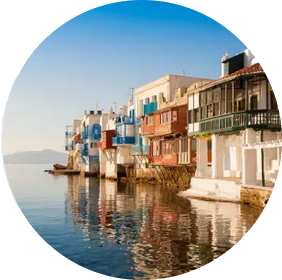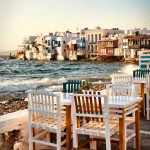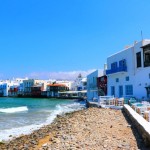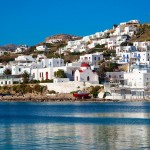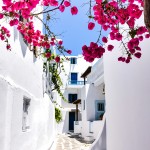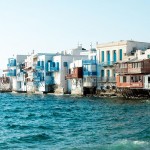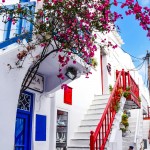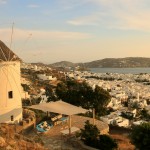Touring the Island
Chora
The island capital is a typical town of the Cyclades, one that will impress you with its sheer beauty and style. Walk along its narrow backstreets, see the little whitewashed houses with the blue-coloured window frames and the small wooden balconies, the pots of colourful fragrant flowers, the little churches & the museums, pass by the busy shops that line the streets and enjoy your shopping and dining - your options are many.
Visit
Panagia Paraportiani Church, the
Town Hall, and the
Castle on the hill overlooking the harbour. Visit also the
Archaeological Museum, the
Folklore Collection of Mykonos, and the
Aegean Maritime Museum. The
Archaeological Museum was established in 1905 and it houses finds from the nearby Rineia Island.
In the warm months of the year, the pedestrian streets of Mykonos - mostly
Matogianni - are buzzing with life as there are designer clothes and jewellery boutiques, cafes, bars and restaurants to cater for all needs any time of day & night. Go for a stroll in the picturesque harbour area and see the multi-coloured fishing boats moored next to each other.
Among the most popular and beautiful neighbourhoods of the town is
Alefkandra or
Little Venice. This quarter was built in the 18th century, and the stately homes of the local rich sea captains and traders of that time line the waterfront. The houses are impressive, with bright-coloured balconies and wooden galleries, and as they are washed by the sea they have earned this neighbourhood its second name, with a direct reference to the famous Italian city. Upon arriving at Little Venice you will see the island’s landmark - the imposing
windmills, overlooking the Aegean Sea.
Ano Mera
This is Mykonos’ second traditional town, which extends inland around the historic monastery of
Panagia Tourliani (a three-aisled 16th c. church with an icon screen that is a masterpiece of wood-carving art). This beautiful picturesque little town, built in the local island style, is located near the centre of the island, along the road towards the northeastern beaches. You’ll find a wide range of traditional tavernas to choose from. North of Ano Mera, in the Ftelia location, you will see the ruins of a Neolithic Age village and a Mycenaean Period tomb dating to the 14th - 13th c. BC. Visit St. George’s Church, the
Gyzi mediaeval castle (13th c.) and the Holy Trinity Church. In the castle which dominates the hill, you can see the archaeological remains dating from the 12th c. BC to the 1st c. BC. Enjoy your coffee or your meal at the town square.
Agios Stefanos
It’s a seaside village with a beautiful beach. Visit Agios Stefanos chapel, the Armenistis lighthouse in the Fanari area, and Choulakia, a cove with an impressive pebble beach.
Ornos
This picturesque village has a sheltered little harbour and a lovely beach washed by crystal-clear waters.
Psarou
This is a seaside village, particularly popular with the rich and famous. Visit nearby Platys Gialos where you will see the ruins of ancient towers dating to the Hellenistic Period (late 4th - 1st c. BC). At a 1km distance, there are two beautiful sandy beaches, Agia Anna and Paraga.
Kalafatis
This village by the sea has a small wharf where fishing boats are moored. Its beach is a favourite spot for water sports fans. Visit the archaeological site at Divounia area, and the chapel in Agia Anna location by the sandy beach.
Make sure you also plan a trip to nearby
Delos Island. This is a very small island with a huge religious significance for the ancient Greeks, as this was the birthplace of the gods Apollo and Artemis. It’s an awesome large archaeological site you should definitely include in your list of must-visit places!
-400x100.png)

